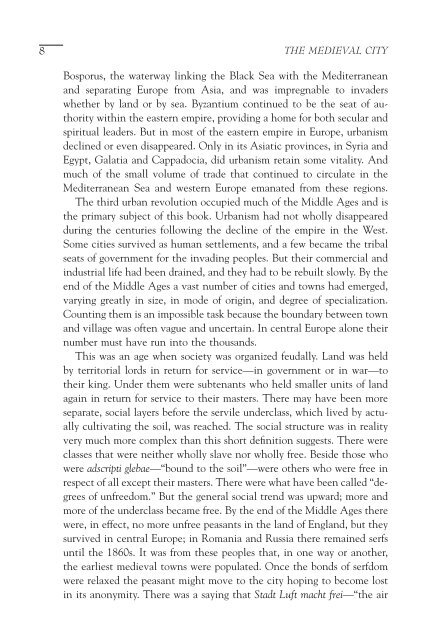CITIES AND TOWN The medieval city.pdf
CITIES AND TOWN The medieval city.pdf
CITIES AND TOWN The medieval city.pdf
Create successful ePaper yourself
Turn your PDF publications into a flip-book with our unique Google optimized e-Paper software.
8<br />
THE MEDIEVAL CITY<br />
Bosporus, the waterway linking the Black Sea with the Mediterranean<br />
and separating Europe from Asia, and was impregnable to invaders<br />
whether by land or by sea. Byzantium continued to be the seat of authority<br />
within the eastern empire, providing a home for both secular and<br />
spiritual leaders. But in most of the eastern empire in Europe, urbanism<br />
declined or even disappeared. Only in its Asiatic provinces, in Syria and<br />
Egypt, Galatia and Cappadocia, did urbanism retain some vitality. And<br />
much of the small volume of trade that continued to circulate in the<br />
Mediterranean Sea and western Europe emanated from these regions.<br />
<strong>The</strong> third urban revolution occupied much of the Middle Ages and is<br />
the primary subject of this book. Urbanism had not wholly disappeared<br />
during the centuries following the decline of the empire in the West.<br />
Some cities survived as human settlements, and a few became the tribal<br />
seats of government for the invading peoples. But their commercial and<br />
industrial life had been drained, and they had to be rebuilt slowly. By the<br />
end of the Middle Ages a vast number of cities and towns had emerged,<br />
varying greatly in size, in mode of origin, and degree of specialization.<br />
Counting them is an impossible task because the boundary between town<br />
and village was often vague and uncertain. In central Europe alone their<br />
number must have run into the thousands.<br />
This was an age when society was organized feudally. Land was held<br />
by territorial lords in return for service—in government or in war—to<br />
their king. Under them were subtenants who held smaller units of land<br />
again in return for service to their masters. <strong>The</strong>re may have been more<br />
separate, social layers before the servile underclass, which lived by actually<br />
cultivating the soil, was reached. <strong>The</strong> social structure was in reality<br />
very much more complex than this short definition suggests. <strong>The</strong>re were<br />
classes that were neither wholly slave nor wholly free. Beside those who<br />
were adscripti glebae—“bound to the soil”—were others who were free in<br />
respect of all except their masters. <strong>The</strong>re were what have been called “degrees<br />
of unfreedom.” But the general social trend was upward; more and<br />
more of the underclass became free. By the end of the Middle Ages there<br />
were, in effect, no more unfree peasants in the land of England, but they<br />
survived in central Europe; in Romania and Russia there remained serfs<br />
until the 1860s. It was from these peoples that, in one way or another,<br />
the earliest <strong>medieval</strong> towns were populated. Once the bonds of serfdom<br />
were relaxed the peasant might move to the <strong>city</strong> hoping to become lost<br />
in its anonymity. <strong>The</strong>re was a saying that Stadt Luft macht frei—“the air
















